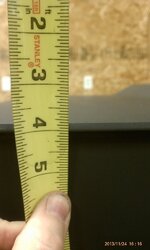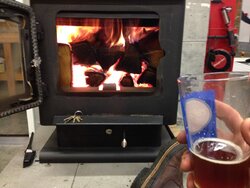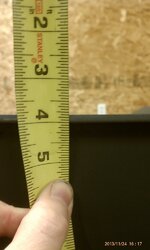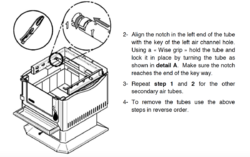Drolet HT2000 vs Englander NC-30
- Thread starter DrewMal
- Start date
-
Active since 1995, Hearth.com is THE place on the internet for free information and advice about wood stoves, pellet stoves and other energy saving equipment.
We strive to provide opinions, articles, discussions and history related to Hearth Products and in a more general sense, energy issues.
We promote the EFFICIENT, RESPONSIBLE, CLEAN and SAFE use of all fuels, whether renewable or fossil.
You are using an out of date browser. It may not display this or other websites correctly.
You should upgrade or use an alternative browser.
You should upgrade or use an alternative browser.
- Status
- Not open for further replies.
Pretty sure I am going with the Austral at a local dealer. Hoping it comes on sale soon! Just need to get a pipe thermometer and probably go with double walled pipe up to the selkirk. I might post some pics of my old furnace before it gets carted away. Have it mostly stripped down now so just have to figure out how to get the combo oil/wood firebox out!
Cheers all!
Cheers all!
pyroheater
New Member
Hello all new member here, I was recently in the market for a new wood stove and have been lurking the forums for quite a while now and finally decided to sign up. I did a search and came across this thread, I was in the same position as the OP and was considering the NC30 versus the HT200.
Both seems to qualify for the $300 federal tax return so that would lower the price just a bit, most likely just cover tax or shipping...
Price wise the NC30 is cheaper and unfortunately I wasn't able to get the cheaper spring price so the cheapest I was able to find is $899 on home depot. I came across a "new" one on craigslist for $650 but I replied a day after it was posted and it was gone, found another used one for $450 but it looked like there was a crack on one of the welds in the firebox and I passed on that one.
I did a search for the HT200 and lowest price I found was $1149 plus shipping from Rural King, Lowes has it listed at just above $1700+ tax&shipping.
It looks like they both have roughly similar firebox sizes NC30 says 3.5 cubic feet and the HT200 says 3.7 cubic feet (specs from drolet website )
The NC30 can take logs of 20" in length while the HT200 can take logs of 22" in length
The NC30 has a smaller viewing window while the HT200 has a bigger, wider window
Both are rated for 2,400 sqft but the NC30 has an output of 75,000 while the HT200 has an output of up to 95,000 BTU's
The NC30 includes a blower (hear it's pretty loud) and the HT200 does not include a blower
The NC30 includes legs and a pedestal while the HT200 only offers a pedestal
Being that the difference in price was only about $200 I ended up going with the Drolet HT200, I couldn't pass up the price and I really like the fact that I can load wider logs and the bigger window was also a plus. I purchased from Rural King and got an extra 15% for a deal they were having on black friday so that brought the price down just about the same as the NC30, but the shipping killed me and brought the price to a little over $1200 which I believe is still a decent price for this particular stove. I just got confirmation that the stove has shipped so all I need now is some double wall stove pipe and I should be good to go. This is replacing an old cast iron smoke dragon that I was eager to unload so this should be a substantial upgrade to something more modern and efficient.
I will post up some pics and hopefully some videos of my installation once everything is hooked up. Can't wait to break her in
Both seems to qualify for the $300 federal tax return so that would lower the price just a bit, most likely just cover tax or shipping...
Price wise the NC30 is cheaper and unfortunately I wasn't able to get the cheaper spring price so the cheapest I was able to find is $899 on home depot. I came across a "new" one on craigslist for $650 but I replied a day after it was posted and it was gone, found another used one for $450 but it looked like there was a crack on one of the welds in the firebox and I passed on that one.
I did a search for the HT200 and lowest price I found was $1149 plus shipping from Rural King, Lowes has it listed at just above $1700+ tax&shipping.
It looks like they both have roughly similar firebox sizes NC30 says 3.5 cubic feet and the HT200 says 3.7 cubic feet (specs from drolet website )
The NC30 can take logs of 20" in length while the HT200 can take logs of 22" in length
The NC30 has a smaller viewing window while the HT200 has a bigger, wider window
Both are rated for 2,400 sqft but the NC30 has an output of 75,000 while the HT200 has an output of up to 95,000 BTU's
The NC30 includes a blower (hear it's pretty loud) and the HT200 does not include a blower
The NC30 includes legs and a pedestal while the HT200 only offers a pedestal
Being that the difference in price was only about $200 I ended up going with the Drolet HT200, I couldn't pass up the price and I really like the fact that I can load wider logs and the bigger window was also a plus. I purchased from Rural King and got an extra 15% for a deal they were having on black friday so that brought the price down just about the same as the NC30, but the shipping killed me and brought the price to a little over $1200 which I believe is still a decent price for this particular stove. I just got confirmation that the stove has shipped so all I need now is some double wall stove pipe and I should be good to go. This is replacing an old cast iron smoke dragon that I was eager to unload so this should be a substantial upgrade to something more modern and efficient.
I will post up some pics and hopefully some videos of my installation once everything is hooked up. Can't wait to break her in
Keep us posted on how that heater works for ya. As everybody knows I likes big honkin steel stoves.
northernontario
Member
I've got an HT2000. I think I'm going into my 3rd winter with it. Can't remember what I paid for it, but got it on sale at TSC Stores in Ontario during the boxing week sales. Came with the blower, although I had to get a replacement as the original was noisy.
I went from a smaller Flame XVR-II (Drolet made) stove to the HT2000. This stove will keep my house (~2000sq ft single story) warm down to about -30 to -35C (before windchill). Beyond that I want to run the furnace. It's installed in a well insulated basement, on a concrete floor, and I use some duct fans to help move air around the house.
Nice big fire box, lets you pack lots of wood in and be less picky about the sizes you cut. I'd definitely recommend the HT2000.
I went from a smaller Flame XVR-II (Drolet made) stove to the HT2000. This stove will keep my house (~2000sq ft single story) warm down to about -30 to -35C (before windchill). Beyond that I want to run the furnace. It's installed in a well insulated basement, on a concrete floor, and I use some duct fans to help move air around the house.
Nice big fire box, lets you pack lots of wood in and be less picky about the sizes you cut. I'd definitely recommend the HT2000.
KindredSpiritzz
Minister of Fire
I like the NC 30 better than the original Austral/Baltic/Myriad, but the new models now have the C-Cast baffle which was my main gripe against the original with the welded in stainless baffle.
Why do you view the welded in stainless baffle in the Drolets as a negative? That was one of the things i liked about the stove. I have no idea what a C cast baffle is in comparison
husky345 vermont resolute
Feeling the Heat
Highbeam
Minister of Fire
Most manufacturers these days use 3/16" for the stove bodies and 1/4" for the top plate if it has a step bend for warp resistence or 5/16" for flat tops. Some of the really cheaper ones get away with 3/16" all around with a step bend, like the Englander 13-NC and the Century stoves.
3/16" is what I measure on the top of the NC30. Maybe the claimed 1/4" plate is one of those nominal things like a 2x4 stud. See photo. It's plenty thick, now the airwash plate inside is really thin at 1/8" and I've managed to melt it while running well under 700. Other stoves have much thicker airwash plates.
Despite this, the NC30 is the leader in welded steel stoves. Unless you don't like the looks of the NC30 for some reason, I can't imagine a good reason for buying a more expensive brand. Some of those cost over three times as much! It's a big box, welded, very clean burning, and same high output as any other stove of the same size.
I don't regret my NC30 purchase at all. She has been a solid performer.
Attachments
Huntindog1
Minister of Fire
Why do you view the welded in stainless baffle in the Drolets as a negative? That was one of the things i liked about the stove. I have no idea what a C cast baffle is in comparison
I think his point was that you can not change them out. if you search there have been some posts on Pacific Energy change outs of the baffle. Nice feature. As long as you dont over fire your stove you shouldn't have to change it out.
I am not sure the new Myriad II or Austral II you will be able to change out the C cast baffle as I looked at one in a Menards Store and the tubes have no
screw tabs that holds the tubes in. So I am wondering if the tubes can be taken out to get the C cast baffle out. Next time I am in there I will see if I can slide the tube one way enough to tilt it down to get it out.
KindredSpiritzz
Minister of Fire
Hmmm, i wasnt aware they could burn out or go bad. Seemed like pretty thick stainless steel to me but i suppose anything can wear out in time. I suspect other parts of the stove will go before the baffle does.
Highbeam
Minister of Fire
Hmmm, i wasnt aware they could burn out or go bad. Seemed like pretty thick stainless steel to me but i suppose anything can wear out in time. I suspect other parts of the stove will go before the baffle does.
Baffles are exposed to far more severe conditions than any other part of the stove. Intense and uneven heat to both sides.
T-roy_
Burning Hunk
There is a cotter pin that holds each tube in, pull the pin and they pop right out. Great stove IMHO. Wifey has ours set for the holidays.I think his point was that you can not change them out. if you search there have been some posts on Pacific Energy change outs of the baffle. Nice feature. As long as you dont over fire your stove you shouldn't have to change it out.
I am not sure the new Myriad II or Austral II you will be able to change out the C cast baffle as I looked at one in a Menards Store and the tubes have no
screw tabs that holds the tubes in. So I am wondering if the tubes can be taken out to get the C cast baffle out. Next time I am in there I will see if I can slide the tube one way enough to tilt it down to get it out.
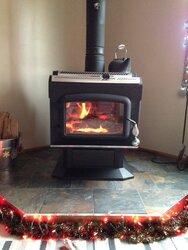
burninwood
New Member
Can't speak for the Englander but we have an HT2000 at the hunt camp - my good friend also has one at his house. I believe he paid $1200ish CAD for it from Costco just last year.
These things are absolute beasts. If you are looking for heat output you won't be disappointed at all.
These things are absolute beasts. If you are looking for heat output you won't be disappointed at all.
northernontario
Member
One complaint I do have about the HT2000... the door casting and hinge design mean that the door doesn't swing 180° open. More like 110°.
Well I didn't go with either I went with the Drolet Austal II which is more suited for my size house I think. So far I am pleased. Hope that in -30 it still keeps up but we will see. If I have to maybe next year I will trade it in for an HT2000 but hopefully this will do the trick.
Had a couple questions though.
How much ash/embers should I leave in the bottom of the stove before emptying some out? I currently have about 1/2 in of ash topped with loads of embers and I just keep putting the wood on top of that and it burns wonderfully.
If it gets really cold out can I run it with the draft 3/4 open or all the way open for a few hours or will that overfire the stove and hurt it?
I did seem to have a problem with the draft when I first fired it but I think it might have been my ash drawer which slides into slots underneath the stove... think it may have been blocked the airflow or maybe I was being paranoid?! I took the ash drawer off the slots and just set it on the floor underneath the stove which works better for me unless I am emptying out ash through the inside hole.
I think thats it for now. We are enjoying it so for. Have no blower or fan for now but might put a fan to blow it through my existing ductwork.
Cheers all and have a great winter!
Had a couple questions though.
How much ash/embers should I leave in the bottom of the stove before emptying some out? I currently have about 1/2 in of ash topped with loads of embers and I just keep putting the wood on top of that and it burns wonderfully.
If it gets really cold out can I run it with the draft 3/4 open or all the way open for a few hours or will that overfire the stove and hurt it?
I did seem to have a problem with the draft when I first fired it but I think it might have been my ash drawer which slides into slots underneath the stove... think it may have been blocked the airflow or maybe I was being paranoid?! I took the ash drawer off the slots and just set it on the floor underneath the stove which works better for me unless I am emptying out ash through the inside hole.
I think thats it for now. We are enjoying it so for. Have no blower or fan for now but might put a fan to blow it through my existing ductwork.
Cheers all and have a great winter!
The stove will burn hotter with the air closed down. It's ok to run the stove with the air open a little further, but it's not designed to run with the air wide open. Running it with the air wide open would allow a lot of unburnt gases to head up the flue and possibly burn there. The stove may or may not overfire, but there is a good chance of exceeding the stove pipe temp rating.
Ducting a wood stove is not code (or insurance) approved.
Ducting a wood stove is not code (or insurance) approved.
Ok so when my flu temp is at the 400deg or so then I close my draft all the way except a tiny bit and it will burn hotter and keep flu from getting too hot. I didn't know that.. I figured if you wanted more heat you had to keep the draft open halfway or so. Thanks for the info.
I'm not planning on ducting it I just have existing ductwork that is right above the stove so I just need a fan in the room to help it go through. Even without a fan we can feel the heat come up through the registers upstairs!
I'm not planning on ducting it I just have existing ductwork that is right above the stove so I just need a fan in the room to help it go through. Even without a fan we can feel the heat come up through the registers upstairs!
Once the fire is burning well, as the primary air is closed, more air comes thru the secondary tubes by the pull of the draft. That leads to more complete combustion of the flue gases and more heat in the firebox.
Huntindog1
Minister of Fire
You should close your air down in increments of around 1/4 to 1/3 ways each time. After each increment the stove is then gonna heat up a little more , you should have a stove top thermometer to monitor stove top temps also along with the exhaust temps on the pipe which should be around 12" to 18" up on the pipe. I would start shutting down the input air when your flues temp gets to around 350 to 400. You will get a feel for it as you learn the stove plus take into account what kind of wood you loaded like size and dryness. Plus how hot of a coal bed do you have at reload time. It all plays a factor in when and how fast you shut the input air down.
Highbeam
Minister of Fire
Once the fire is burning well, as the primary air is closed, more air comes thru the secondary tubes by the pull of the draft. That leads to more complete combustion of the flue gases and more heat in the firebox.
This is not what happens for me. If I want the hottest nc30 I give it more air. You really don't have much control over stove temps with a non cat other than how much fuel you put in it and how often you reload.
- Status
- Not open for further replies.
Similar threads
- Replies
- 51
- Views
- 4K
- Replies
- 2
- Views
- 563
- Replies
- 848
- Views
- 25K
- Replies
- 13
- Views
- 7K


